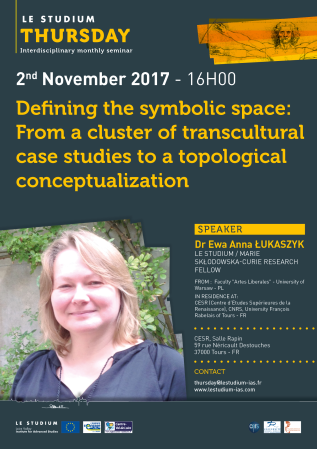Defining the symbolic space: From a cluster of transcultural case studies to a topological conceptualization
CESR, Salle Rapin
59 rue Néricault Destouches
37000 Tours
France
Presentation
The concept of an open, universal “space” as a matrix of interactions between diverse symbolic elements follows the hypothesis of the “dissolution of cultures” (Auflösung der Kulturen), proposed by Wolfgang Welsch in 1992. With increasing insistence, the recent humanities deal with contents (such as iconic elements, narrative structures, concepts, etc.) travelling between cultures, without entirely belonging to any of them. The study of such phenomena clashes against the classical views on the cultural construction of meaning. This is why the idea of creating a paradigm of unitarian symbolic space to replace the vision of separate, even if interrelating, cultures appears as particularly tempting. Such a notion of symbolic space would facilitate the study of the non-local mechanisms of constituting the meaning and permit to grasp the human potential of transgressing the limitations imposed by the cultural inscription.
This strand of reflection, apparently so novel, has surprisingly a long antecedence in the history of ideas. The notion of the Adamic language, spoken by first humans in the paradise, is a metaphor resuming not only the questioning of the hypothetical pre-cultural beginnings of the human kind, but, far more importantly, the perspectives of a transcultural becoming of man. Crossing the boundaries of the culturally defined ways of acting, speaking and thinking opens up a new dimension of creativity. The traces of such daring, unorthodox explorations are to be gathered in the medieval and early-modern history; the cluster of transcultural case studies (the Adamic language being just one of the problems to be studied) forms an unexplored margin of the contemporary humanities.
On the other hand, the reflection on symbolic space encompassing both cultures and the interstices between them opens up a new necessity of interaction between humanities and the exact sciences. Mathematical topology, as well as the recent advancements in physics appear as a promissory source of inspiration for a conceptualization of the symbolic space defined as a continuum of actualized and possible interactions between complex forms of information, usually treated as the separate matter studied by humanities (myths, poems, paintings, etc.). Once such a conceptualization is made, the interpretation of complex symbolic entities, as well as the relationships they establish between themselves forming non-local structures (such as global circulation of literary motives or rhythmic patterns), may be inscribed in or derived from a determined hypothesis concerning the topological.
Speaker
LE STUDIUM / MARIE SKŁODOWSKA-CURIE RESEARCH FELLOW
FROM : University of Warsaw - Faculty "Artes Liberales" - PL
IN RESIDENCE AT: CESR (Centre d’Etudes Supérieures de la Renaissance), CNRS, University François Rabelais of Tours - FR







